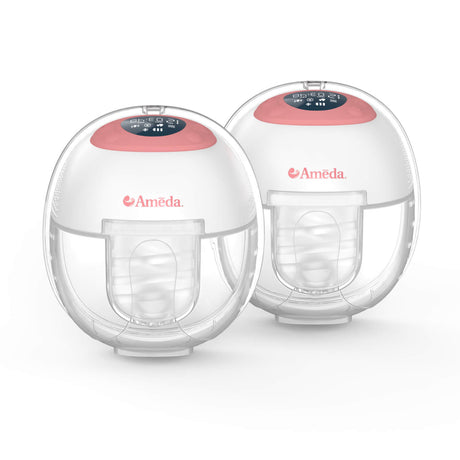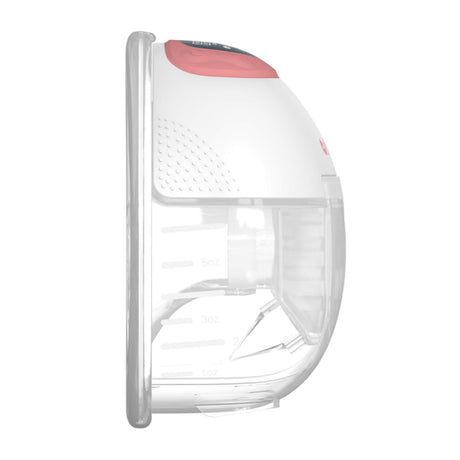Published:
Choosing the right breast pump is essential for breastfeeding success and a comfortable pumping experience. With many moms balancing work, home, and personal schedules, choosing between portable and wearable breast pumps can make a big difference. In this guide, we explore both types to help you decide which breast pump is right for your lifestyle and milk expression needs.
Understanding Portable Breast Pumps
Portable, or non-wearable, breast pumps are the ones with tubing that sit outside your bra. They plug in, may use a battery, or can be manual. Many moms use portable pumps for daily milk expression at home or in a hospital setting.
Advantages of Portable Breast Pumps
-
Nothing extra inside your bra - just the flanges on your breasts
-
Easy to see the bottles while you pump, so you can keep an eye on volume.
-
Great for planned, sit-down sessions at work or home (including power-pumping)
Understanding Wearable Breast Pumps
Wearable breast pumps sit inside your bra with built-in collection cups. They’re battery powered and truly hands-free, so you can pump while moving around, working at a desk, or on the go.
Why Moms Choose Wearable Pumps
-
Hands-free inside-the-bra design. No bottles hanging off the front
-
Fewer loose parts to manage while you’re up and about
-
Low-profile under clothing for more discretion at work or in public
-
Rechargeable convenience (most charge via USB) for pumping away from outlets
-
Travel-friendly for commutes, errands, trips and busy days
Tip: a well-fitting bra and correct flange size help comfort and reduce leaks with any wearable.
Comparing Key Factors
Comfort and Convenience
-
Wearable: truly hands-free, no tubing or cords, sits inside your bra - easy to move around or take calls.
-
Portable (non-wearable): can be hands-free with a pumping bra; simple to set up for seated sessions.
Efficiency and Milk Output
Modern wearables and portable pumps offer comparable vacuum strength. Milk output depends more on fit and flange size, a good seal, settings, a consistent schedule, and the specific pump and controls you’re comfortable using. Session length is a personal workflow choice.
Portability and Noise
Wearable pumps sit inside your bra with no external tubing, so they’re easy to move with and low-profile under clothing. Portable (non-wearable) pumps also travel well; you’ll carry the motor and bottles and may want outlet access if not using a battery.
Noise levels are model-dependent and often the same as, or lower than, portable pumps. Because a wearable’s motor is closer to your ears, it can seem a bit louder even though overall volume remains very quiet.
Cost Considerations
Pricing is model dependent for both wearable and portable pumps. Your out-of-pocket cost will vary based on insurance coverage and what’s included (extras like parts, batteries/charger, and warranty). Compare the total cost of ownership. Upfront price, plus replacement parts, and accessories you’ll actually use.
Lifestyle Alignment
Choose a pump that fits your day, not the other way around. If you’re often on the move or need discretion during calls or errands, a wearable keeps you hands-free. If you prefer planned, seated sessions or want plug-in power for longer stretches, a portable (non-wearable) pump is a good match. Many moms use both at different times as routines change.
Which Breast Pump Is Right for You?
Start with how you’ll pump most days. If you’re bouncing between meetings, school runs, or errands, a wearable keeps you untethered. If you prefer set blocks at a desk or bedside, or want a simple, plug-in setup, a portable (non-wearable) pump fits better. Both styles can work equally well; comfort, flange fit, and a steady routine matter most. Many moms switch between the two as their week changes.
Tips for Maximizing Pumping Success
Keep a steady routine
When possible, line sessions up with your baby’s feeding pattern.
Fuel and hydrate
Drink fluids and eat balanced meals to support overall well-being.
Make it comfortable
A relaxed spot, warm compress and privacy can help let-down.
Dial in fit
Use the right flange size and a supportive bra so the nipple moves freely without rubbing.
Set it to comfort and then raise to maximum comfort vacuum levels
Start gently and adjust suction levels to the maximum comfortable vacuum level for optimal pumping efficiency.
Care for your equipment
After each session, clean all parts that contact milk per your pump’s instructions and follow any directed disinfection/sterilization steps. Let parts air-dry completely and replace wear items (e.g., valves/diaphragm) as recommended. Because of Ameda’s unique design, you should never have to clean your tubing.
Use hands-on help. Brief massage or gentle breast compressions can encourage milk flow.
Find the Perfect Pump for Your Pumping Journey
There isn’t a single “best” pump. The right one is the one you’ll actually use. Think about where you’ll pump most, how hands-free you need to be, and whether plug-in power matters. Both wearable and portable (non-wearable) pumps can work well when the fit is right.
Learn more about the Ameda GLO wearable pump and our portable options (Mya Joy, Mya Joy PLUS, and Pearl), or contact us with questions.



